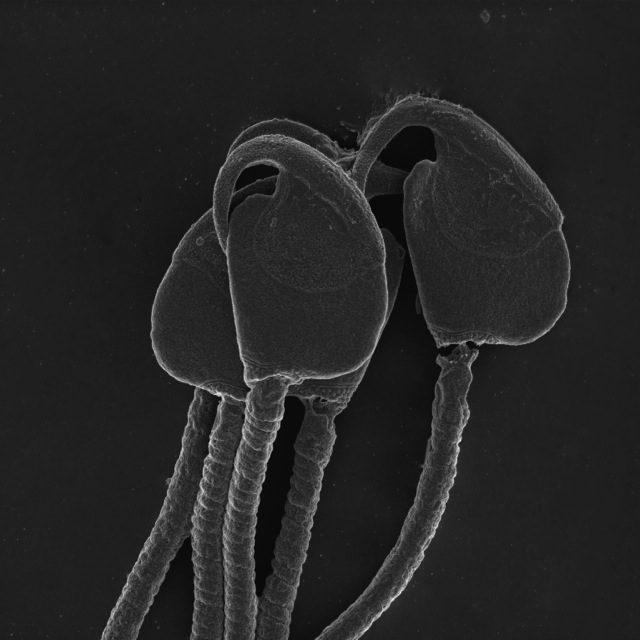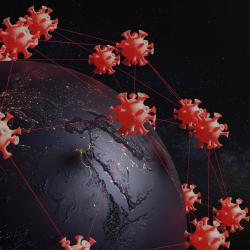Wide Heads Help Sperm Swim Together
Sperm cells are among the most diverse cells in the animal world, despite having the same purpose—to find and fertilize an egg. The sperm of some species have a single tail, others have no tail or multiple tails, and some have hooks on their headlike structures. Scientists don’t know the reason for such extreme diversity among sperm cells, but new research shows that certain shapes and proportions are associated with swimming behavior in some mouse species.

University of Maryland researchers used machine learning to discover that sperm with a wide head relative to length are more likely to clump together and swim collectively, a rare behavior that sometimes helps them reach an egg faster. The study provides a new method for understanding how form and function are related in cells with complex behaviors in all animals, including humans. Their results were published on September 22, 2021, in the journal Proceedings of the Royal Society B.
“This is really a form versus function study asking how shape and behavior are associated, but we've taken a new approach, using machine learning to do these automated morphometric analyses,” said Kristin Hook, the lead author of the paper who was a postdoctoral associate in UMD’s Department of Biology during the study. “These mice have sperm that are sort of paddle shaped, and we determined that it’s the sperm with a wider paddle shape that are more likely to form groups and swim cooperatively.”
Sperm are usually solitary swimmers, but in a few species, the sperm adhere to one another and swim collectively until they get close to the egg. Hook and her colleagues hypothesized that sperm shape was an important factor in whether sperm were solitary or collective swimmers. But they didn’t know which features of shape were significant.
To find out, they looked at sperm in six closely related species of mice, some with sperm that swim in groups and some with solitary sperm. The researchers measured the length and width of sperm heads using a meticulous and time-consuming hand-measuring method and then with an automated computer system. After verifying that the computer could accurately perform the measurements, they fed high-resolution images of sperm cells from all six mouse species into the computer system and asked it to find the distinguishing traits that were most relevant to the sperm’s social behavior.
Now that the researchers know width is an important characteristic thanks to this study, they can begin to investigate how and why it affects sperm behavior in these mice.
“We think there may be some adhesive mechanism holding the sperm together, and the wider the cell the more adhesion,” said Heidi Fisher, assistant professor of biology at UMD and a co-author of the study. “What we really want to find is the molecular mechanisms responsible for it, the adhesive molecule that glues the cells together. But this is the first step. Identifying aspects of the cell shape that are associated with group formation can help us narrow in on likely targets for that adhesive molecule.”
In the video above, clusters of sperm from Peromyscus maniculatus can be seen joined at the head and swimming together. Credit: Heidi Fisher, UMD.
To conduct the automated measurement and machine learning aspects of the study, Fisher and Hook teamed up with Wolfgang Losert, a professor in UMD’s Department of Physics and Institute for Physical Science and Technology, and members of his lab.
“One of the most exciting aspects of this work is that we were able to combine expertise from across campus to ask an interesting question about biology,” Fisher said. “My lab wouldn't have been able to do the automated morphometrics and the machine learning aspects of this work had we not collaborated with Wolfgang Losert’s lab. So, the collaboration was really important.”
By publishing the code they developed for the automated measuring and machine learning portions of the study, the team hopes that other researchers will be able to apply the same methods to understanding other forms of complex cell behavior.
"This work highlights the importance of data analytics experts and subject matter experts working together to break down barriers between fields and push the boundaries of knowledge," said Losert.
###
Additional authors of this study from UMD include Leonard Campanello (Ph.D. ’20, physics) and physics Ph.D. student Qixin Yang.
This study was supported by the National Science Foundation (Award No. 1711817), Air Force Office of Scientific Research (Award No. FA9550-16-1-0052), and Eunice Kennedy Shriver National Institute of Child Health and Human Development (Award Nos. K99/R00 and R00HD071972). This story does not necessarily reflect the views of these organizations.
The research paper, The social shape of sperm: using an integrative machine-learning approach to examine sperm ultrastructure and collective motility, Kristin A. Hook, Qixin Yang, Leonard Campanello, Wolfgang Losert and Heidi S. Fisher, was published on September 22, 2021, in Proceedings of the Royal Society B.
Writer: Kimbra Cutlip
Media Relations Contact: Abby Robinson, 301-405-5845, abbyr@umd.edu





